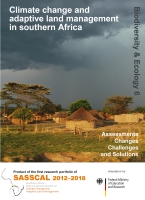
|

Department of Biology Institute of Plant Science and Microbiology |
| Division BEE > Biodiversity & Ecology > Vol.6 > Article 5.7 |
Biodiversity & Ecology
Journal of the Division Biodiversity, Evolution and Ecology of Plants , Institute for Plant Science and Microbiology, University of Hamburg.
Food security Research article Open Access Sustaining rural livelihoods through an integrated landscape approach
Resumo: Os nossos estudos socio-económicos na região do Zambezi, Namíbia, mostram que o sistema agrícola é caracterizado por uma diversidade extremamente baixa, não fornecendo nutrientes sufi cientes para assegurar a segurança alimentar de uma população em crescimento. Verifi camos que os programas para a protecção da vida selvagem e fl orestas não estão a harmonizar bem com a agricultura de subsistência. Enquanto que os políticos e as partes interessadas externas prestam atenção à biodiversidade em áreas protegidas, estes ignoram em grande parte a agrobiodiversidade. A política agrícola em particular tem maior probabilidade de limitar o desenvolvimento de paisagens resilientes, tal como visto, por exemplo, nos subsídios direccionados para o cultivo do milho. Quanto à muito discutida ligação entre o desenvolvimento e a conservação, as abordagens existentes, tais como a Gestão de Recursos Naturais Comunitários (CBNRM) e a gestão conjunta dos recursos piscatórios, não têm em conta a importância da partilha de benefícios e a segurança alimentar. Os incentivos económicos oferecidos por estes sistemas sob a forma de quotas de caça ou operações de pesca recreativa, não são sufi cientes para travar a perda progressiva da biodiversidade, nem oferecem alternativas para a exploração dos recursos naturais, dos quais a população local está altamente dependente. O artigo discute determinados resultados da investigação e sugere uma abordagem mais holística para a gestão da paisagem.
Suggested citation: |
